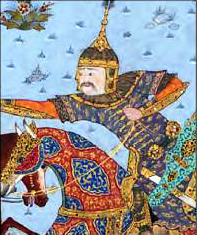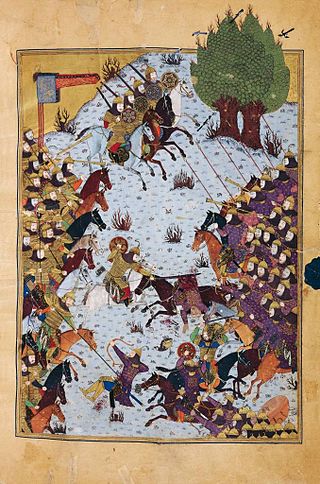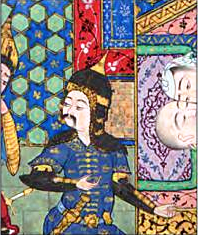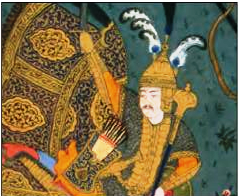
Afrasiyab is the name of the mythical king and hero of Turan. He is the main antagonist of the Persian epic Shahnameh, written by Ferdowsi.

Siyâvash, also spelled Siyâvoš or Siavash (سياووش), is a major figure in the Shahnameh. He is introduced by Ferdowsi as the son of Kay Kāvus, who reigns as Shah in the earliest days of Greater Iran for over a century. His name means "the one with black stallions" after his horse Shabrang Behzād, who accompanies him during a trial of righteousness.

Bijan and Manijeh is a love story in Ferdowsi's Shahnameh. Bijan was the son of Giv, a famous Iranian knight during the reign of Kay Khosrow, the Shah of Iran, and Banu Goshasp, the heroine daughter of Rostam. Bijan falls in love with Manijeh, the daughter of Afrasiab, the king of Turan and the greatest enemy of Iran. The tale of his suffering and Manijeh’s constancy has been quoted by several others.

Farangis or Frigis is a female character in the Persian epic Shahnameh. She is the eldest daughter of Afrasiab, king of Turan. She is also the second and favourite wife of Siyâvash, the saintlike prince of Iran and mother of a legendary hero and later Shah of Iran, Kai Khosrow. Although a Turanian by birth, Farangis shows loyalty to her husband's kingdom and dynasty. She accompanies her son when he leaves Turan in the hopes of gathering an Iranian army to avenge Siyâvash.

Sudabeh or Sodaba is a character in the Persian epic Shahnameh. She was princess of Hamavaran kingdom and later, becomes the wife of Kay Kāvus, King of Iran, and stepmother to prince Siyavash.

The Kayanians are a legendary dynasty of Persian/Iranian tradition and folklore which supposedly ruled after the Pishdadians each of whom held the title Kay, meaning "king". Considered collectively, the Kayanian kings are the heroes of the Avesta, the sacred texts of Zoroastrianism, and of the Shahnameh, the national epic of Greater Iran.

Piran e Viseh is a Turanian figure in Shahnameh, the national epic of Greater Iran. Beside Shahnameh, Piran is also mentioned in other sources such as Tabari and Tha'ālibī. He is the king of Khotan and the spahbed of Afrasiab, the king of Turan. He is described as a wise and intelligent man, seeking to bring peace to Iran and Turan. In old Iranian writings, Piran and Aghrirat are the only Turanians that have been described positively. Piran plays a vital role in the story of Siavash, the story of Kay Khosro and the story of Bizhan and Manizhe. Piran was killed by Goudarz in the battle of Davazdah Rokh. Kay Khosro mourned the death of Piran and ordered to wash his body with Musk and Ambergris and be buried in the cave of Zibad. In Persian culture, Piran is a symbol of wisdom. It has been said that Karim Khan called Mohammad Khan Qajar "Piran Viseh". Piran is often compared to Bozorgmehr.

Goudarz is one of the main Iranian heroes in Shahnameh, the national epic of Greater Iran, and progenitor of one of its most prominent families. He is son of Kashvad, father of Giv and Roham and the grandfather of Bizhan. His first appearance is in the time of Kay Kavus and thereafter he appears almost in every story of the heroic age, sometimes he is the spahbed of Iranian Army. His personality is described very positively with traits such as loyalty, patience and altruism.

Giv or Gev is a legendary Iranian knight and one of the main heroes in the New Persian epic poem of Shahnameh, the national epic of Iran. A member of the House of Karen, he is the son of Godarz, brother of Roham and father of Bizhan, as well as a descendant of Kaveh the Blacksmith.

Fariburz is an Iranian hero in Shahnameh, the national epic, of Greater Iran. He is son of Kay Kavus and brother of Siyâvash. He appears in the story of Mazandaran, the story of Sohrab and the story of Siavash. But his most important role is when Giv brings Kay Khosrow back to Iran. Tous, another Iranian hero is opposed to the rulership of Kay Khosrow in favor of Fariburz, because Kay Khosrow is grandson of Afrasiab. Kay Kavus, unable to choose between Kay Khosrow and Fariburz, decides to give the rulership to the one who can successfully capture a fortress in Ardabil. Tous and Fariburz are unable to take the fortress, while Giv and Kay Khosrow are able to take it easily. Kay Khosrow thus becomes the king of Iran. Fariburz thereafter obeys Kay Khosrow and participates in the wars between Iran and Turan. Fariburz married Farangis, Kay Khosrow's mother. Fariburz is among those heroes that disappear in the snow after Kay Khosrow's ascend.

Gorgin is an Iranian hero in Shahnameh, during the reigns of Kay Kavus and Kay Khosrow. He is son of Milad. According to Tabari, the name of Milad's father is also Gorgin, which is possible because in ancient Iran, it was a usual practice to name the first grandson after the grandfather. Beside Shahnameh, Gorgin also appears in other Iranian epics such as Faramarz Nama and Bahman Nama.

Gostaham is the name of a number of Iranian heroes in Shahnameh.

Davāzdah Rokh is a story in Shahnameh. This relatively long story is described as one of the finest stories of Shahnameh in terms of "plot, dramatic description, and insight into human nature".

Bahram is an Iranian hero in Shahnameh, the national epic of Greater Iran. He is son of Goudarz and brother of Rohham, Giv and Hojir. In the story of Siavash, he and Zange-ye Shavaran are Siavash's counselors. They unsuccessfully try to convince Siavash not to go to Turan. When Siavash goes to Turan and abandons Iranian army, Bahram is put in command of the Iranian army until the arrival of Tous. His most important adventure is in the story of Farud, where he fights with Turanian army along with other Iranian heroes. When Iranian army is marching toward Turan, they encounter Farud, who along with Tokhar (تُخوار) are standing on a mountain. Tous, the spahbed of Iranian army does not know Farud and think that he is a Turanian foe. He sends Bahram to go there and kill both of them. When Bahram arrives at Farud, Farud introduces himself and says that he is son of Siavash and want to avenge Afriasiab. Bahram comes back to Tous and tells him that they are not enemy and instead they want to join Iranian army to fight against Afrasiab. Tous, however, does not believe this and orders to kill Farud. Bahram unsuccessfully tries to restrain Tous and Iranians from killing Farud and his companion. However, Farud was eventually slain by Rohham and Bizhan.
House of Goudarz or Goudarzian (گودرزیان) is an important Iranian family in Shahnameh and Persian mythology. They are descendants of Kave the Blacksmith. Gooderzian is also sometimes known as free man, meaning he does not want to be defeated or captured.
House of Viseh is the most important Turanian clan in Shahnameh and Persian mythology. They are descendants of Tur. Tur is father of Zadashm and grandfather of Viseh. Viseh is the leading member of this clan. Viseh first war with Qaren is in the Iran-Turan war, both of which are not alive in Shahnameh afterwards.
House of Nowzar also known as Nowzarian (نوذریان) is an important Iranian clan in Shahnameh and Persian mythology. Nowzar ruled Iran for seven years. After his death, the grandees of Iran didn't recognize his sons Tous and Gostaham as the shahanshah of Iran and instead they gave the throne to Kayanian dynasty.

In the epic poem Shahnameh, Tageuo is one of the Turan heroes in charge of a border state between Iran and Turan. His state was the third province attacked by Iranians under the command of Tous after Chaeam and Kasa-Roud.

Nastihan is a Turanian hero who was involved in the Iran-Turan wars. He fled from the Battle of Homavn. Afrasiab sent Nastihan to the Iranian war after killing his other son Houman with 10,000 men.





















